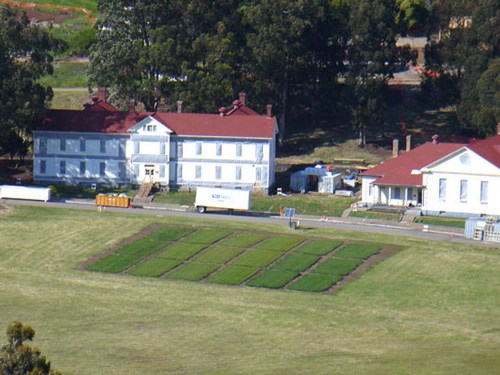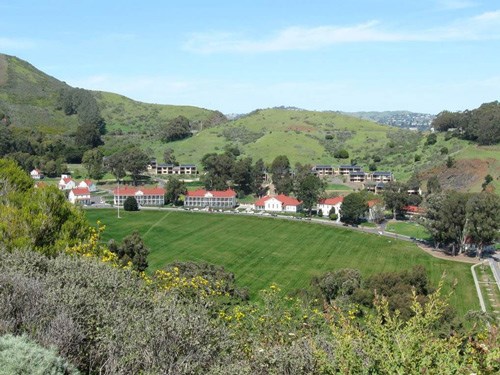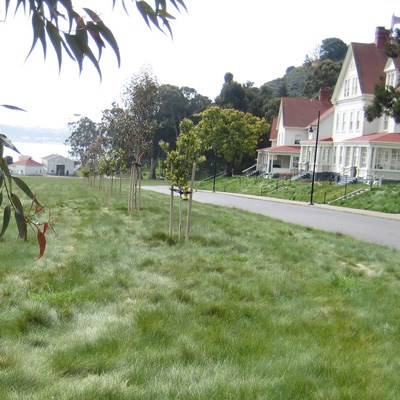Golden Gate National Recreation Area - Sausalito, CA
To rehabilitate the Fort Baker parade ground to reflect its 1939 character with more sustainable turf that reduces mowing, water, and fertilizer requirements.

NPS Photo
Fort Baker is a 335-acre former U.S. Army post located immediately to the north of the Golden Gate Bridge that is now a unit of Golden Gate National Recreation Area. The core of the park is comprised of over twenty-five historic buildings clustered around a thirteen-acre parade ground. The parade ground is an important historic feature of the cultural landscape. Prior to rehabilitation, the parade ground lawn required a significant commitment of maintenance time and resources to present a well-kept appearance, including regular mowing, irrigation, and fertilization. The resource-intensive maintenance requirements of the parade ground lawn were also misaligned with the new uses of the site: as a national park, eco-friendly luxury resort, conference center, and environmental stewardship program.
The Solutions
The National Park Service identified the Fort Baker historic district for rehabilitation to its 1939 appearance. Buildings, structures, and impermeable asphalt parking lots that post-dated the 1939 treatment date were removed. Missing historic shade trees were replaced with cultivars that were consistent in character with the missing historic trees. New bike lanes and pedestrian walks were installed along the perimeter of the parade ground to encourage recreational use. (The parade ground lawn is not used for events of any type.)

NPS Photo
Additional Information
Fort Baker, a unit of Golden Gate National Recreation Area, is home to the Cavallo Point Lodge (the first LEED Gold certified national park lodge), the Bay Area Discovery Museum, and the Institute at Golden Gate, a program of the Golden Gate Parks Conservancy designed to facilitate dialogue and action on global environmental issues. All three facilities have strong ties to environmental conservation and education. Learn more about the Fort Baker parade ground rehabilitation on the Golden Gate National Recreation Area website.
Year: 2009
Treatment: Rehabilitation
Landscape Type: Designed, historic military post
Measurable Benefits*
Mowing time savings: 550 hours/year
Mower fuel savings: 660 gallons/year
Potable irrigation water savings: 14.3 million gallons/year
*All figures estimated based on comparison with turf maintenance schedules at nearby park units.

Services Provided
- Climate change mitigation/carbon sequestration
- Urban heat island mitigation
- Biodiversity/habitat protection and enhancement
- Recreational/visible green space enhancement
- Enhanced resilience to withstand change
- Scientific/cultural information yield
NPS Green Parks Plan Features
- Continuously Improve Environmental Performance
- Be Climate Friendly and Climate Ready
- Be Water Wise
- Adopt Best Practices
- Foster Sustainability Beyond Our Boundaries
Last updated: April 25, 2016

